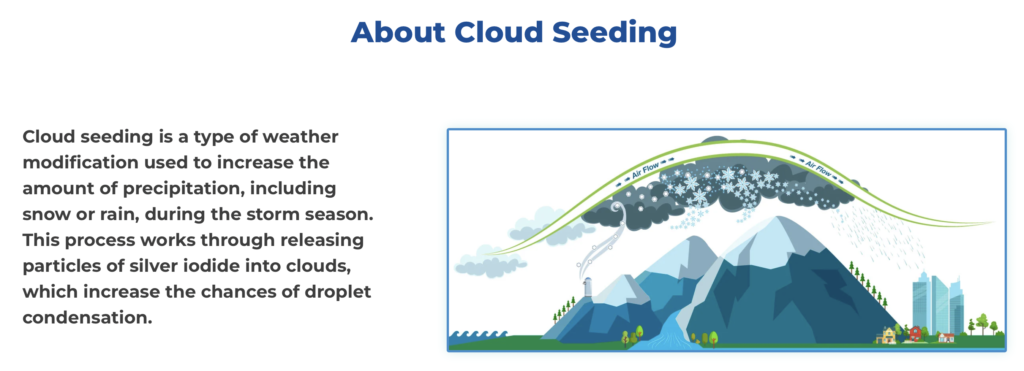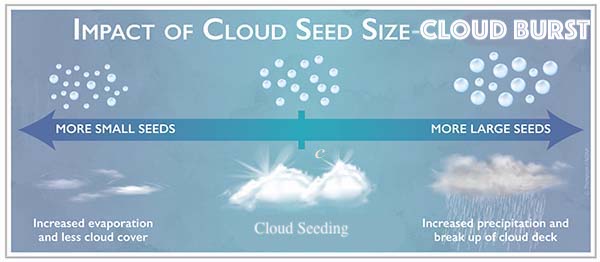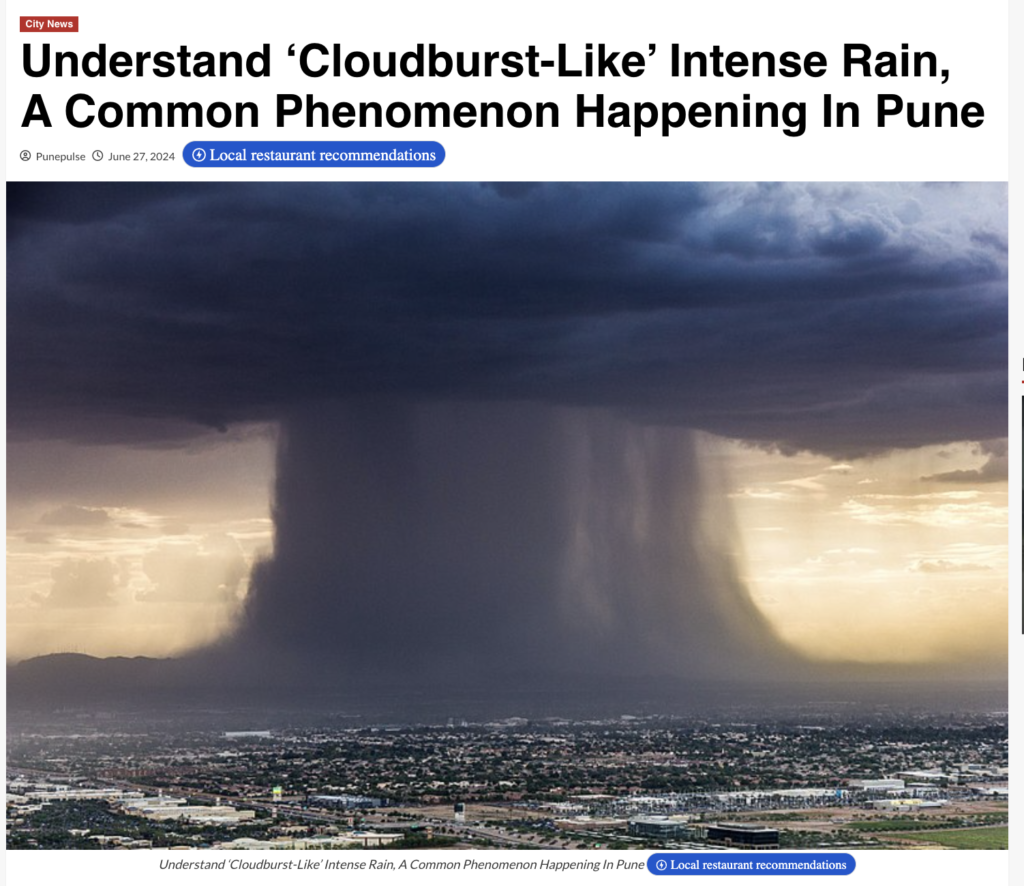New research has uncovered the complicated problems of weather modification with the clouds and the critical role that particle size plays in such endeavors. Even small changes in particle size might cause not only a stronger local rain but also the early disintegration of the clouds as a result not intended by the team of scientists. This discovery has introduced a “Goldilocks Problem” in the climate intervention method which politicians often recommend for the cooling of the Earth.
Cloud seeding, known as artificial rain, has been investigated as a possible remedy for a number of problems in Uttarakhand. After 1,883 forest fire incidents in the state that year, the Uttarakhand forest department was considering using cloud seeding to create fake rain in June 2019. According to Jai Raj, Uttarakhand’s main chief conservator of forests and head of the forest force, the department has started evaluating the viability of cloud seeding and intends to submit a comprehensive funding proposal for approval from the government, with an implementation target of 2020 if successful. In order to change the microphysical processes within clouds and cause rainfall, cloud seeding entails releasing chemicals such as sodium chloride, calcium chloride, or silver iodide into the atmosphere to serve as ice nuclei or cloud condensation. More than 50 nations have adopted this technique for a variety of purposes, including combating Delhi’s smog.

In April 2021, the Uttarakhand High Court also directed the state government to investigate the possibility of using artificial rain to extinguish raging forest fires, emphasizing the need to put out fires within two weeks and implement the National Green Tribunal’s 2017 guidelines. Despite these discussions and judicial directives, concrete reports of successful artificial rain operations in the region are absent. The primary method of artificial rain currently in use, cloud seeding, is not always reliable and can be expensive, with concerns about the environmental impact of sprayed chemicals. Researchers are also exploring alternative, non-polluting methods, such as using plasma laser pulses to trigger rainfall.
Uttarakhand, including Dehradun, frequently experiences heavy rainfall, leading to natural disasters like landslides and swollen rivers. The India Meteorological Department (IMD) regularly issues “orange” and “red” alerts for heavy to very heavy rainfall in various districts, including Dehradun, Tehri, Pauri, Nainital, Champawat, and Udham Singh Nagar. Many people are questioning whether these rain events are a result of nature or if they are man-made.
6 May 2024: As forest fires continue to devastate parts of Uttarakhand, the state’s Chief Secretary, Radha Raturi, announced on May 06 a series of measures aimed at controlling the spread of the flames and mitigating further damage. Raturi revealed that the Indian Air Force (IAF) has been called in to aid firefighting efforts, and plans are underway to implement a pilot cloud seeding project to induce rainfall in the affected regions. Radha Raturi said, “Incidents of forest fire have increased. CM held a meeting the day before. For compliance with those directions, the Forest Department has been informed. The Forest Department has given responsibility for each district to its senior officials. Pauri Garhwal is facing the worst. For that, DM Pauri has also spoken with the Air Force. IAF choppers are now carrying water from Srinagar and sprinkling it. We are also bringing in a new project – IIT Kanpur has experimented with cloud seeding…We are now trying to have rainfall through cloud seeding in Uttarakhand too, so that forest fires come under control…We have spoken with the CM, and he has agreed to a pilot project from Pauri.”
Does this Cloud Seeding idea have a Goldilocks problem?

A Goldilocks dilemma
Like Goldilocks and her bowls of porridge, the authors found that there is an ideal particle size that is ‘just right’ for increasing the reflectivity (or albedo) of marine clouds. Particles that are too large can form large droplets; these can collide with each other, falling out of the cloud as rain. Even a tiny number of large particles (as few as one in a million) can increase rainfall and break up the cloud layer. Conversely, very small particles may either not form cloud droplets at all or may cause an existing cloud to evaporate away faster. In each case, the result could be more sunlight striking the surface, not less.
Heavy downpour lashed Jammu and Kashmir, Uttarakhand, Himachal Pradesh, Haryana, Rajasthan, Punjab, and Delhi, which recorded its highest rainfall in a single day in July 2023
The most recent significant flood event in North India, specifically the Himalayan region, as of today, 7 July 2025, is the 2025 Uttarakhand flash flood, which occurred after heavy rain caused flooding and landslides, killing at least 5 people and leaving over 50 missing. This event, which swept through Dharali village in Uttarakhand state, was attributed to a cloudburst (breakup of the cloud layer), a common occurrence during India’s June-September monsoon season.
May god have mercy on us 🙏 #dharaliflood #uttarakhandflood #uttarkashiflood #flood @pushkardhami @PMOIndia @narendramodi please take immediate action. Rescue them pic.twitter.com/Ch4WnNmE95
— Navneet Panwar (@navneetpanwar96) August 5, 2025
Hygroscopic Seeding and Droplet Growth: One method that directly aims to increase droplet size is hygroscopic cloud seeding. This technique involves dispersing hygroscopic materials, such as table salt (sodium chloride) or calcium chloride (CaCl2), into warm clouds (clouds with temperatures above freezing). These hygroscopic particles readily absorb water vapor, forming larger cloud condensation nuclei (CCN). When these larger CCN activate, they form larger cloud droplets that can grow more rapidly through collision and coalescence (CC) processes.
Research, such as the Cloud–Aerosol Interaction and Precipitation Enhancement Experiment (CAIPEEX) in India, has provided observational evidence supporting this. In seeded convective clouds, researchers detected increased concentrations of seeding materials (like potassium and chlorine from flares containing KClO4 and CaCl2) and observed larger mean effective radii (re) of droplets compared to non-seeded clouds at similar altitudes. Specifically, the study noted an increase in the concentration of small droplets (around 3 μm) and mid-sized droplets (around 14 μm) in seeded stratus and convective clouds, suggesting that even small CCN from the seeding material could activate and grow. The formation of drizzle drops (diameter > 100 μm) was also observed at higher altitudes in seeded clouds, indicating an active collision-coalescence process and a “tail effect” where larger particles in the flares initiate the growth of large cloud drops and drizzle.

Ref:
- Cloud Seeding Program: Science Behind Cloud Seeding. [ https://idwr.idaho.gov/iwrb/programs/cloud-seeding-program/science-behind-cloud-seeding/ ]
- Cloud seeding. [ https://en.wikipedia.org/wiki/Cloud_seeding ]
- Identifying the seeding signature in cloud particles from hydrometeor residuals. [ https://amt.copernicus.org/articles/17/2387/2024/ ]
- Frequently Asked Questions. [ https://www.tdlr.texas.gov/weather/weatherfaq.htm ]
- Turbulence-induced droplet grouping and augmented rain formation in cumulus clouds. [ https://www.nature.com/articles/s41598-024-61036-z ]
- Measurements of cloud droplet size distributions in seeded warm cumulus clouds. [ https://link.springer.com/article/10.1007/BF00876938 ]
- https://sawpa.gov/santa-ana-river-watershed-cloud-seeding/
Also Read:
